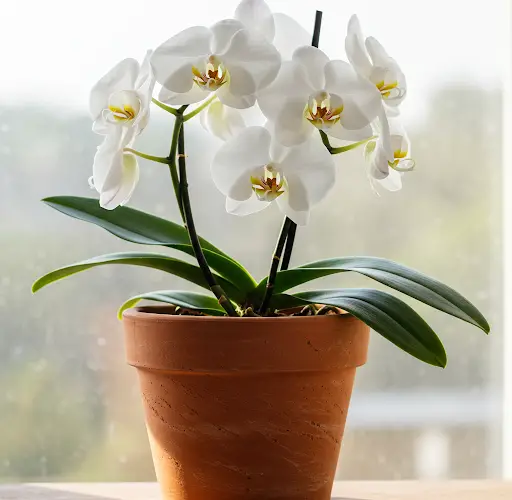How to Care for Orchids to Ensure Abundant Blooming and Healthy Growth
Orchids are known to be delicate and somewhat demanding plants, requiring special care to bloom frequently and profusely. Proper maintenance is key to achieving vibrant flowers and healthy growth. Below are essential aspects to consider when caring for orchids, including lighting, temperature, watering schedules, humidity levels, and effective homemade natural fertilizers.
1. Lighting: The Key to Flowering
One of the first and most important factors in orchid care is lighting. Without adequate light, orchids will not bloom. These plants thrive in bright, indirect sunlight. They prefer a location near a south-facing window, but they should be protected from direct sunlight, which can cause burns on the leaves.
During the autumn and winter months, when natural light is limited, supplemental lighting is necessary. Using a grow light or a phytolamp can help extend the daylight period to about 12 hours, ensuring the plant receives sufficient illumination. Keeping a stable light source is crucial for encouraging the development of flower buds.
2. Temperature: Encouraging Blooms with Proper Climate Control
Orchids require a specific temperature range for optimal growth. The ideal daytime temperature for orchids is between 20 to 24°C (68-75°F), while at night, it should drop to 15-18°C (59-64°F). A temperature fluctuation of about 5-6 degrees between day and night helps stimulate orchids to bloom. This drop mimics their natural environment, triggering the flowering process.
If your home temperature remains constant, you can manually create this fluctuation by moving the plant to a slightly cooler area at night, such as near a window or on a balcony (if temperatures are not too extreme).
3. Watering and Humidity: Providing the Right Conditions
Orchids love humidity and should be misted frequently to maintain the right moisture levels. However, special care is required when flower buds appear. Water droplets can damage the buds, causing them to rot or fall off prematurely. Instead of misting the buds directly, you can place a shallow bowl of water near the plant to naturally increase the surrounding humidity.
During the dormant period (after flowering), orchids require much less water. Watering once every 2-3 weeks is sufficient. However, when new roots, leaves, and flower spikes start to develop, orchids need more frequent watering. The best way to determine when to water is by observing the roots. When orchid roots turn silvery-white, it’s time to water. Always use room-temperature, filtered, or dechlorinated water to avoid root damage.
4. Nutrient Supply: Feeding for Optimal Growth
Orchids require fertilization during their active growth phase, from root and leaf development until the first bud opens. Natural homemade fertilizers are an excellent alternative to store-bought chemical fertilizers. Here are some effective and easy-to-make organic orchid feeds:
Garlic Water Fertilizer
Garlic is a powerful natural stimulant for plant growth and immunity. It contains sulfur and other trace elements that help orchids grow strong and healthy.
How to prepare:
- Take 3 cloves of garlic, finely chop or crush them.
- Pour 1 liter of slightly warm water over the garlic.
- Let the solution steep for 24 hours.
- Strain the mixture and dilute it with water in a 1:3 ratio.
- Use this garlic water to water the orchids at the root once every 3-4 weeks.
This garlic solution not only promotes growth and flowering but also has antimicrobial properties, protecting the plant from fungal infections and pests like spider mites and thrips.
Lemon Water Fertilizer
Lemon juice contains citric acid, which helps maintain the proper pH balance in the orchid’s growing medium. It also stimulates the plant’s immune system, strengthens its leaves, and encourages flowering.
How to prepare:
- Take 1 teaspoon of fresh lemon juice.
- Mix it in 1 liter of water.
- Stir well and use the solution to water the orchid at the root on moist soil.
Frequency: Healthy orchids can be watered with this solution once a month. Weaker plants or those in recovery can benefit from lemon water every two weeks.
Succinic Acid Fertilizer
Succinic acid is an excellent growth stimulant that improves root development, strengthens leaves, and promotes flowering.
How to prepare:
- Dissolve 2 tablets of succinic acid (approximately 100 mg) in 1 liter of warm water.
- Mix well.
- Use this solution for root watering or leaf spraying once a month.
This natural supplement boosts the plant’s overall health and vitality, making it more resilient to stress and environmental changes.
5. Additional Care Tips for Orchids
- Repotting: Orchids should be repotted every 1-2 years using a well-draining orchid mix, such as bark, sphagnum moss, and perlite.
- Air Circulation: Ensure good air circulation around the plant to prevent mold or bacterial growth.
- Flower Spike Maintenance: Once the orchid has finished blooming, trim the flower spike just above the third node to encourage new growth and potential reblooming.
- Pest Control: Regularly check for pests like mealybugs, thrips, and spider mites. If detected, treat the plant with neem oil or an insecticidal soap.
Conclusion
By following these care techniques, you can ensure your orchid remains healthy, grows vigorously, and produces abundant blooms. Proper lighting, temperature control, humidity management, and organic fertilizers play crucial roles in maintaining a thriving orchid. Incorporating natural feeding solutions like garlic water, lemon water, and succinic acid can significantly enhance the plant’s growth and flowering potential. With the right approach, your orchids will reward you with stunning, long-lasting blooms year after year!



